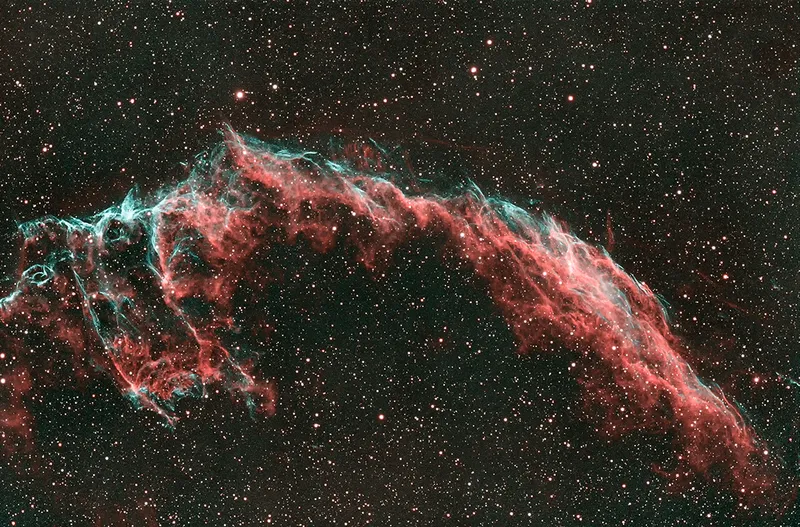Atik Cameras Apx26 is a 16-bit astrophotography camera, a 26-megapixel CMOS available in both mono and one-shot-colour variants.
Our review model is a monochrome version which we paired with an Atik electronic filter wheel to take images using our 2-inch filters.
During these economically challenging times, comparing the cost of equipment to apparently similar offerings is often worthwhile.

The Atik Apx26 Mono is at the higher end of the price range when compared to other cameras using the same CMOS sensor
So we were especially keen to discover what sets the Atik device apart from the competition.
The build quality and design of the Apx26 is exemplary, with each and every facet demonstrating the high level of attention that has been given to even the smallest details.
These Atik cameras have industrial applications, and in your hands they really feel like high-end, professional imaging devices, which is what they are.
The crossover between scientific imaging applications and long-exposure astrophotography is a happy coincidence that suits our hobby very well.
The chunky build of the Apx26 gives a reading on the scales of 1kg (without a filter wheel), so it is a reassuringly heavy camera.
We paired it with our 150mm triplet refractor and the weight was useful in offsetting the hefty lens and balancing the telescope centrally on our mount.
But the Apx26 can be used across a range of telescope sizes and types, with some consideration given to image scale, while binning the results 2x2 or 3x3 could provide a useful arcsecond-to-pixel ratio.

Getting started
After downloading and installing the latest Atik core software bundle, it took us only a few minutes to get the camera mounted and connected to our favourite software, start up the electronic cooling and then start taking images.
Atik has taken the approach of providing useful preset imaging options for the Apx26 – Low, Medium and High – which alter the gain and offset settings accordingly, with a ‘Custom’ tab for setting them independently.
There is also a choice of Power Save, Normal and Fast exposure speed options, but the application of these choices is not immediately obvious.
We chose ‘Normal’ as a reasonable guess, but soon discovered (after a quick call to Atik technical support) that long exposures over 500 seconds are not possible in this mode, and that we needed to choose ‘Power Save’ instead.
We mention this as something to factor in when choosing a camera.

With Atik being a UK-based company with European production facilities, we have always found the technical support to be first-rate.
The only real issue we had during the review period was with the night sky.
With a lack of astronomical darkness, we were limited to taking narrowband exposures with our H-alpha and OIII filters.
The summer sky is awash with suitable targets, and we chose the Crescent Nebula (NGC 6888), the Eastern Veil Nebula (NGC 6992) and the Dumbbell Nebula (M27).
These familiar objects allowed us to compare our results from the Apx26 to previous efforts.
How the Atik Apx26 mono camera performs

The Apx26 really seemed to pull the intricate details out of the almost-twilight skies.
Even the very faint outer reaches of M27, mere wispy remnants of ancient nebulosity, were faithfully gathered by the camera in just 5- to 15-minute exposures.
This impressive performance with narrowband filters effectively demonstrates that the camera would be equally capable through standard RGB filters.
The response through our Ha filter showed that sensitivity to light in the red range is most capable, while the OIII filter reveals the same about blue and green light.
We would relish the opportunity to use this excellent camera over a season of dark skies.
Overall, the monochrome Apx26 is a premium-quality, professional astronomy camera and would make a very solid investment in the world of 16-bit CMOS astrophotography.

Sony IMX571 CMOS sensor
Not too long ago, discussions revolved around the superiority of old-style CCD sensors over the newer CMOS type.
At the time, most were firmly in the CCD camp.
However, the latest generation of back-illuminated Sony sensors has really turned things around.
The IMX571 Sony sensor that forms the basis of the Apx26 is in APS-C format, giving a diagonal image area of 28.3mm.
The pixel array is 6,244 x 4,168, each individual pixel being 3.76μm square.
This sensor offers true 16-bit capability, which results in an enormous dynamic range, producing cameras able to simultaneously gather light from the faintest nebulae and the brightest stars without issue.
The images gathered by the Apx26 are not affected by ‘amp glow’ artefacts, and right out of the box, without any calibration being required, we were most impressed by the low-noise capabilities of the sensor and the hardware Atik has designed to support it.
This is true even when using the high-gain setting and 15-minute exposures.

5 best features
Atik software and ASCOM camera control
Atik cameras can be controlled via ASCOM protocols, so they can be used with a range of popular image-capture applications including SharpCap, SGPro and NINA. Atik’s in-house Atik Capture software is also provided for full, automatic sequencing-style camera control along with auto-guiding, cooling and
filter wheel control.
M54 attachment and back focus
The front of the camera has a female M54 x 0.75 thread, this wide aperture allowing vignette-free images when attaching various accessories. An M54-to-2-inch barrel adaptor is included, or direct attachment to the Atik filter wheel is possible. The back focus distance is around 17mm.
USB hub
The camera is controlled via a USB 3.0 connection for fast, stable transfer of the 26MB images, and a good-quality 2-metre cable is included. In addition, a two-port USB hub on the rear panel provides options for use with low-bandwidth accessories such as filter wheels or auto-focusers.
512MB memory buffer
Atik has always had an uncompromising approach to the internal camera design, optimising performance with low-noise electronics, and has included a 512MB memory buffer to assist with stable image transfer, avoiding dropped frames and artificial artefacts in downloaded images.
Thermoelectric cooling and 12V power
The Apx26 requires a 12V DC power supply to run. A 12V cigar-lighter-type cable is supplied, but a separate PSU will be required. A powerful but quiet fan draws air over the heat sink and thermoelectrically chilled sensor. This allows the device to be cooled to 35°C below the ambient temperature.
Vital stats
- Price: £5,379
- Sensor: Sony IMX571
- Resolution: 6,244 x 4,168
- Exposure range: 1ms–24h
- Connectivity: USB 3.0
- Size: 152mm x 89mm
- Weight: 1kg
- www.atik-cameras.com
This review appeared in the October 2023 issue of BBC Sky at Night Magazine
